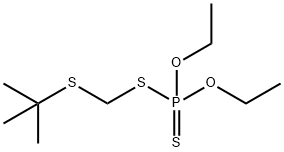???? C??? ??, ??, ??
??? ??
Terbufos is a colorless to pale yellow liquid.
??
Terbufos is used to control soil pests in maize, sugar beet and
vegetables and also nematodes in sugar beet and bananas.
?? ??
Technical product is a clear, colorless to pale yellow liquid. Used as a soil insecticide.
??? ?? ??
Hydrolyzes under alkaline conditions [EPA, 1998]. Insoluble in water.
?? ???
Organothiophosphates, such as Terbufos, are susceptible to formation of highly toxic and flammable phosphine gas in the presence of strong reducing agents such as hydrides. Partial oxidation by oxidizing agents may result in the release of toxic phosphorus oxides. Terbufos decomposes in the presence of acids or bases .
???
Moderate fire risk. Toxic by ingestion.
Cholinesterase inhibitor. Questionable carcinogen.
????
Terbufos may be fatal if swallowed, inhaled, or absorbed through the skin. Repeated inhalation or skin contact may progressively increase susceptibility to poisoning.
????
This is a liquid organophosphorus pesticide. Fire may produce irritating or poisonous gases. Hydrolyzes under alkaline conditions.
???
Insecticide, Nematicide: This insecticide and nematicide is applied at planting
time to corn, sugar beets, sorghum, maize, cotton,
bananas and cabbage. It controls corn rootworms, wireworms,
white grubs, maggots, billbugs and nematodes.
Some above-ground pests can be controlled when soil has
been treated with terbufos. Terbufos has no residential use.
Not approved for use in EU countries. A U.S. EPA restricted
use Pesticide (RUP).
???
AC 921000®; ARAGRAN®;
CONTRAVEN®; COUNTER®; COUNTER 15G
SYSTEMIC INSECTICIDE®; PLYDOX®; TERBUROX®
??? ??
A potential danger to those involved in the manufacture, formulation or application of this organophosphate soil insecticide.
????
Soil. Oxidized in soil to its primary and secondary oxidation products, terbufos sul-
foxide and terbufos sulfone, respectively (Bowman and Sans, 1982; Chapman et al., 1982;
Wei, 1990). Both metabolites were formed due to micobial activity and chemical oxidation
(Chapman et al., 1982). Incubation of terbufos (5 μg/g) in a loamy sand containing
Nitrosomonas sp. and Nitrobacter sp. gave terbufos sulfoxide and terbufos sulfone as the
primary products. After 2 weeks, the sulfoxide increased the bacterial population >55%
and the sulfone increased the fungal population at least 66% (Tu, 1980). The half-life in
soil is 9–27 days (Worthing and Hance, 1991).
Chemical/Physical. Terbufos and its degradation products terbufos sulfoxide and ter-
bufos sulfone followed first-order disappearance in natural, sterilized natural and distilled water at 20°C. In natural and distilled water, the sulfoxide and su
?? ?? ??
Terbufos is the S-tertiary butyl homologue of phorate (the S-ethyl homolope).
Consequently, the compound is more strongly sorbed to soils;
however, the metabolism is essentially the same, with activation via
thiooxidation and to a lesser degree oxidative desulfuration being the
principal mechanisms. The metabolic routes for terbufos biotransformation
have mainly been studied in soils where oxidation to the sulfoxide is
rapid and further metabolism to the sulfone quite slow. In common with
other phosphorodithioate insecticides, the phosphorodithioate moiety is
excreted in mammalian urine as diethyl phosphate, O,O-diethyl phosphorothioate
and O,O-diethyl phosphorodithioate and in humans the
concentrations of these metabolites have been found useful as indicators
of exposure to the insecticide.
?? ??
The metabolic routes of terbufos are essentially the
same in plants, animals, and soils, involving the oxidation
of the sulfide group into the sulfoxide, then sulfone,
and oxidative desulfuration to the corresponding
oxons, followed by hydrolysis to diethyl hydrogen phosphorodithioate,
phosphorothioate, and phosphate. DT
50 in
soil is 9–27 d.
?? ??
UN3018 Organophosphorus pesticides, liquid, toxic, Hazard Class: 6.1; Labels: 6.1-Poisonous materials. UN2783 Organophosphorus pesticides, solid, toxic, Hazard Class: 6.1; Labels: 6.1-Poisonous materials. UN2810 Toxic liquids, organic, n.o.s., Hazard Class: 6.1; Labels: 6.1Poisonous materials, Technical Name Required.
? ???
Organophosphates are susceptible to formation of highly toxic and flammable phosphine gas in the presence of strong reducing agents such as hydrideds and active metals. Partial oxidation by oxidizing agents may result in the release of toxic phosphorus oxides. Incompatible with oxidizers (chlorates, nitrates, peroxides, permanganates, perchlorates, chlorine, bromine, fluorine, etc.); contact may cause fires or explosions. Keep away from alkaline materials, strong bases, strong acids, oxoacids, epoxides. Strong oxidizers may cause release of toxic phosphorus oxides. Organophosphates, in the presence of strong reducing agents, such as hydrides, may form highly toxic and flammable phosphine gas. Keep away from alkaline materials.
??? ??
In accordance with 40CFR165 recommendations for the disposal of pesticides and pesticide containers. Must be disposed properly by following package label directions or by contacting your local or federal environmental control agency, or by contacting your regional EPA office.
???? ?? ?? ? ???
???
?? ??








